Transportin 3 promotes a nuclear maturation step required for efficient HIV-1 integration
- PMID: 21901095
- PMCID: PMC3161976
- DOI: 10.1371/journal.ppat.1002194
Transportin 3 promotes a nuclear maturation step required for efficient HIV-1 integration
Abstract
The HIV/AIDS pandemic is a major global health threat and understanding the detailed molecular mechanisms of HIV replication is critical for the development of novel therapeutics. To replicate, HIV-1 must access the nucleus of infected cells and integrate into host chromosomes, however little is known about the events occurring post-nuclear entry but before integration. Here we show that the karyopherin Transportin 3 (Tnp3) promotes HIV-1 integration in different cell types. Furthermore Tnp3 binds the viral capsid proteins and tRNAs incorporated into viral particles. Interaction between Tnp3, capsid and tRNAs is stronger in the presence of RanGTP, consistent with the possibility that Tnp3 is an export factor for these substrates. In agreement with this interpretation, we found that Tnp3 exports from the nuclei viral tRNAs in a RanGTP-dependent way. Tnp3 also binds and exports from the nuclei some species of cellular tRNAs with a defective 3'CCA end. Depletion of Tnp3 results in a re-distribution of HIV-1 capsid proteins between nucleus and cytoplasm however HIV-1 bearing the N74D mutation in capsid, which is insensitive to Tnp3 depletion, does not show nucleocytoplasmic redistribution of capsid proteins. We propose that Tnp3 promotes HIV-1 infection by displacing any capsid and tRNA that remain bound to the pre-integration complex after nuclear entry to facilitate integration. The results also provide evidence for a novel tRNA nucleocytoplasmic trafficking pathway in human cells.
Conflict of interest statement
The authors have declared that no competing interests exist.
Figures

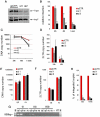

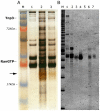
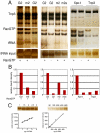
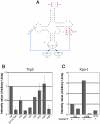

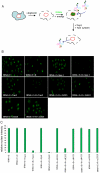


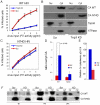
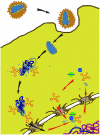
Similar articles
-
Inhibition of HIV-1 infection by TNPO3 depletion is determined by capsid and detectable after viral cDNA enters the nucleus.Retrovirology. 2011 Dec 6;8:98. doi: 10.1186/1742-4690-8-98. Retrovirology. 2011. PMID: 22145813 Free PMC article.
-
Spatiotemporal binding of cyclophilin A and CPSF6 to capsid regulates HIV-1 nuclear entry and integration.mBio. 2025 Apr 9;16(4):e0016925. doi: 10.1128/mbio.00169-25. Epub 2025 Feb 27. mBio. 2025. PMID: 40013779 Free PMC article.
-
Transportin-1 binds to the HIV-1 capsid via a nuclear localization signal and triggers uncoating.Nat Microbiol. 2019 Nov;4(11):1840-1850. doi: 10.1038/s41564-019-0575-6. Epub 2019 Oct 14. Nat Microbiol. 2019. PMID: 31611641
-
The Role of Capsid in the Early Steps of HIV-1 Infection: New Insights into the Core of the Matter.Viruses. 2021 Jun 17;13(6):1161. doi: 10.3390/v13061161. Viruses. 2021. PMID: 34204384 Free PMC article. Review.
-
The HIV-1 Capsid: From Structural Component to Key Factor for Host Nuclear Invasion.Viruses. 2021 Feb 10;13(2):273. doi: 10.3390/v13020273. Viruses. 2021. PMID: 33578999 Free PMC article. Review.
Cited by
-
HIV-1 uncoating by release of viral cDNA from capsid-like structures in the nucleus of infected cells.Elife. 2021 Apr 27;10:e64776. doi: 10.7554/eLife.64776. Elife. 2021. PMID: 33904396 Free PMC article.
-
A cyclophilin homology domain-independent role for Nup358 in HIV-1 infection.PLoS Pathog. 2014 Feb 20;10(2):e1003969. doi: 10.1371/journal.ppat.1003969. eCollection 2014 Feb. PLoS Pathog. 2014. PMID: 24586169 Free PMC article.
-
The Role of Capsid in HIV-1 Nuclear Entry.Viruses. 2021 Jul 22;13(8):1425. doi: 10.3390/v13081425. Viruses. 2021. PMID: 34452291 Free PMC article. Review.
-
HIV-1 uncoating is facilitated by dynein and kinesin 1.J Virol. 2014 Dec;88(23):13613-25. doi: 10.1128/JVI.02219-14. Epub 2014 Sep 17. J Virol. 2014. PMID: 25231297 Free PMC article.
-
Structure, Function, and Interactions of the HIV-1 Capsid Protein.Life (Basel). 2021 Jan 29;11(2):100. doi: 10.3390/life11020100. Life (Basel). 2021. PMID: 33572761 Free PMC article. Review.
References
-
- Greber UF, Fassati A. Nuclear import of viral DNA genomes. Traffic. 2003;4:136–143. - PubMed
Publication types
MeSH terms
Substances
Grants and funding
LinkOut - more resources
Full Text Sources
Other Literature Sources
Molecular Biology Databases

